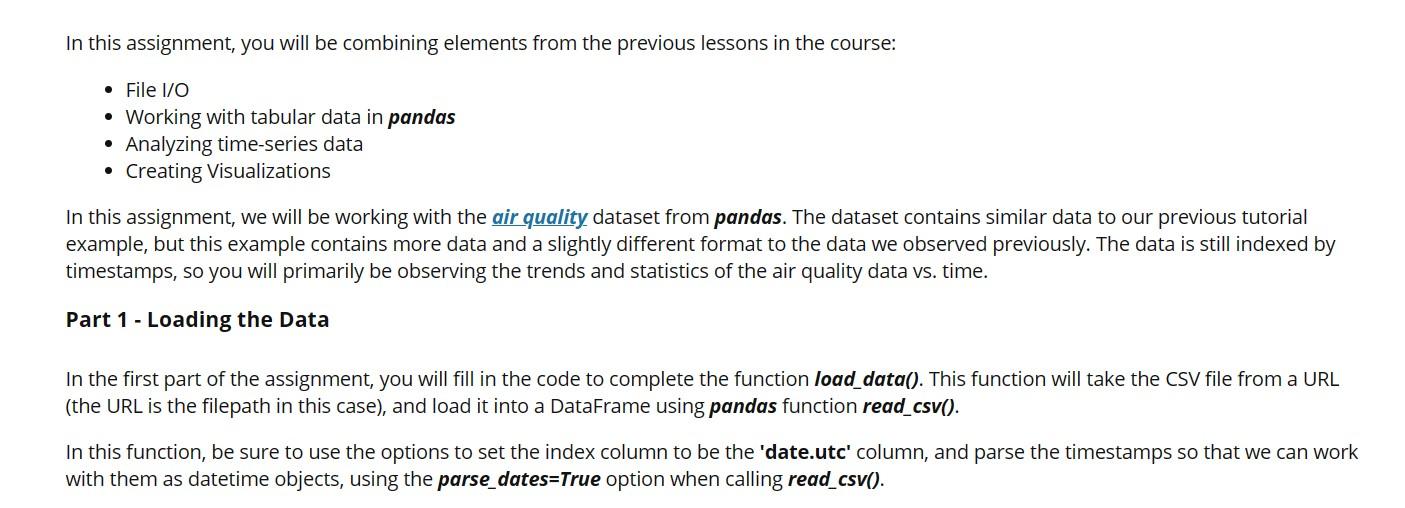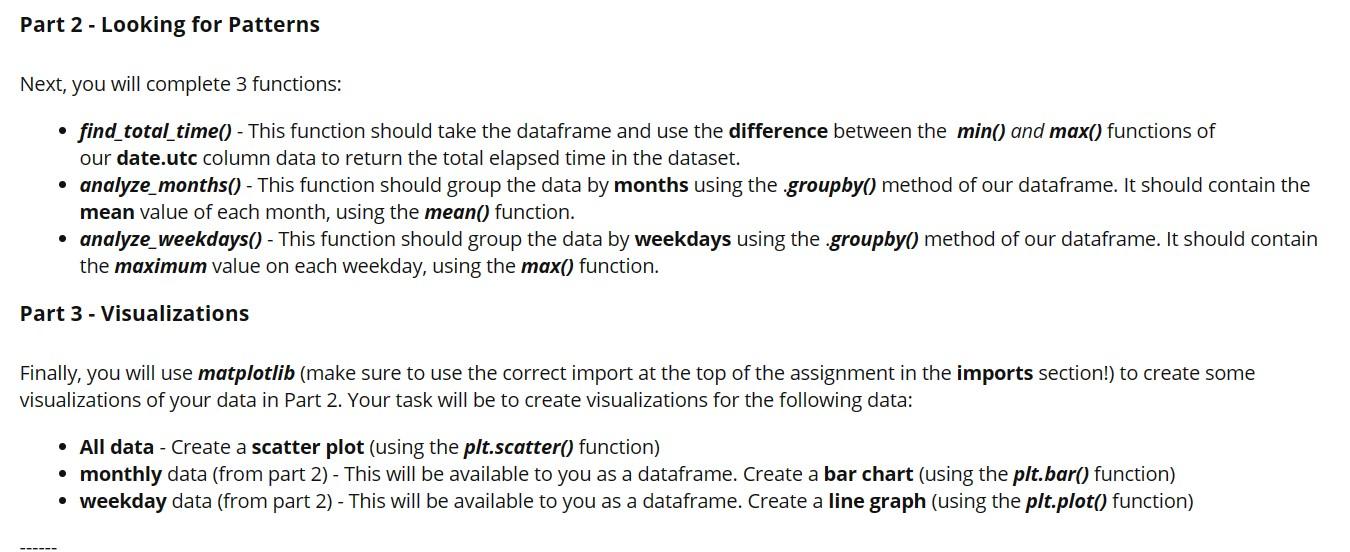

In this assignment, you will be combining elements from the previous lessons in the course: - File 1/0 - Working with tabular data in pandas - Analyzing time-series data - Creating Visualizations In this assignment, we will be working with the air quality dataset from pandas. The dataset contains similar data to our previous tutorial example, but this example contains more data and a slightly different format to the data we observed previously. The data is still indexed by timestamps, so you will primarily be observing the trends and statistics of the air quality data vs. time. Part 1 - Loading the Data In the first part of the assignment, you will fill in the code to complete the function load_data(). This function will take the CSV file from a URL (the URL is the filepath in this case), and load it into a DataFrame using pandas function read_csv(). In this function, be sure to use the options to set the index column to be the 'date.utc' column, and parse the timestamps so that we can work with them as datetime objects, using the parse_dates=True option when calling read_csv(). Part 2 - Looking for Patterns Next, you will complete 3 functions: - find_total_time() - This function should take the dataframe and use the difference between the min( ) and max() functions of our date.utc column data to return the total elapsed time in the dataset. - analyze months() - This function should group the data by months using the groupby() method of our dataframe. It should contain the mean value of each month, using the mean() function. - analyze weekdays() - This function should group the data by weekdays using the groupby() method of our dataframe. It should contain the maximum value on each weekday, using the max() function. Part 3 - Visualizations Finally, you will use matplotlib (make sure to use the correct import at the top of the assignment in the imports section!) to create some visualizations of your data in Part 2. Your task will be to create visualizations for the following data: - All data - Create a scatter plot (using the plt.scatter() function) - monthly data (from part 2) - This will be available to you as a dataframe. Create a bar chart (using the plt.bar() function) - weekday data (from part 2) - This will be available to you as a dataframe. Create a line graph (using the plt.plot() function) In this assignment, you will be combining elements from the previous lessons in the course: - File 1/0 - Working with tabular data in pandas - Analyzing time-series data - Creating Visualizations In this assignment, we will be working with the air quality dataset from pandas. The dataset contains similar data to our previous tutorial example, but this example contains more data and a slightly different format to the data we observed previously. The data is still indexed by timestamps, so you will primarily be observing the trends and statistics of the air quality data vs. time. Part 1 - Loading the Data In the first part of the assignment, you will fill in the code to complete the function load_data(). This function will take the CSV file from a URL (the URL is the filepath in this case), and load it into a DataFrame using pandas function read_csv(). In this function, be sure to use the options to set the index column to be the 'date.utc' column, and parse the timestamps so that we can work with them as datetime objects, using the parse_dates=True option when calling read_csv(). Part 2 - Looking for Patterns Next, you will complete 3 functions: - find_total_time() - This function should take the dataframe and use the difference between the min( ) and max() functions of our date.utc column data to return the total elapsed time in the dataset. - analyze months() - This function should group the data by months using the groupby() method of our dataframe. It should contain the mean value of each month, using the mean() function. - analyze weekdays() - This function should group the data by weekdays using the groupby() method of our dataframe. It should contain the maximum value on each weekday, using the max() function. Part 3 - Visualizations Finally, you will use matplotlib (make sure to use the correct import at the top of the assignment in the imports section!) to create some visualizations of your data in Part 2. Your task will be to create visualizations for the following data: - All data - Create a scatter plot (using the plt.scatter() function) - monthly data (from part 2) - This will be available to you as a dataframe. Create a bar chart (using the plt.bar() function) - weekday data (from part 2) - This will be available to you as a dataframe. Create a line graph (using the plt.plot() function)








